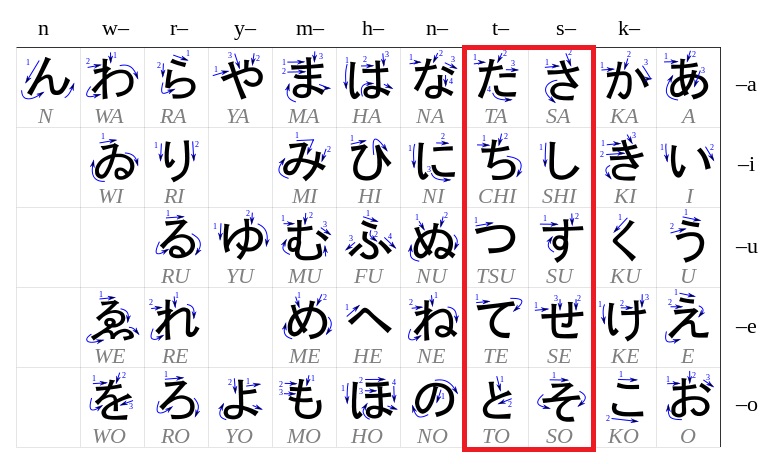Overview

In this lesson, we will be going through the 3rd and 4th columns of the Hiragana chart, as well as the additional sounds that can be generated from those letters.
Hiragana – Third column
The third column is associated with the ‘s’ sound, so the the first letter, さ, is read as ‘sah’, but here we have our first exception. The second letter, し, is not pronounced ‘see’, but pronounced as ‘she’. The rest of the letters in this column are as per normal. So without further ado, let’s learn how to write these letters!
1.
2. 
3. 
4.
5. 
Hiragana – Fourth Column
This column is associated with the ‘t’ sound, but here we have not one, but two exceptions, so take extra care when memorizing the letters. The second letter, ち, is pronounced ‘chee’ instead of ‘tee’. The third letter, つ, is pronounced by adding a ‘t’ sound in front of ‘su’ and saying it really quickly, like the ‘tsu’ in tsunami (which is a word loaned from Japanese). Do listen to the audio clips if you’re not sure about the pronunciations!
1.
2. 
3. 
4. 
5. 
Additional Sounds
This time, the letters in both columns can produce additional sounds by having those two strokes added to them. The ‘s’ column becomes ‘z’, while the ‘t’ column becomes ‘d’.
However, there are some exceptions again. Remember the exceptions we had earlier? They’re problematic characters as well when it comes to additional sounds! じ and ぢ are read as ‘jee’, while づ is read as ‘do’.
1. ざ
Romaji : Za
2. じ
Romaji: Ji
3. ず
Romaji: Zu
4. ぜ
Romaji: Ze
5. ぞ
Romaji: Zo
6. だ
Romaji: Da
7. ぢ
Romaji: Ji
8. づ
Romaji: Zu
9. で
Romaji: De
10. ど
Romaji: Do
You might have noticed that there is no difference in the pronunciations of ず and づ, as well as for ち and ぢ, and you’re right! There used to be a difference in pronunciation, but approximately 300 years ago, people started reading the letters out in the same way. Today, the only difference between the letters is how they are written. Some words use ず while other words use づ, for instance.
Doubled Consonants
The letter つ can be used to form double consonants. That is done by placing a small つ in between two letters, and the second letter has to be a consonant. For example, っ can be placed between ざ (Za) and し (Shi) to form ざっし. This adds an additional consonant for the second letter, so the Romaji of ざっし is Zasshi. You read this by splitting the word after the added consonant, so you can think of Zasshi and Zas-shi. Click on the audio player below if you’re not sure about the pronunciation.
Let’s have another example. By putting っ in between が(Ga) and こう (Kou), we get
がっこう (Gakkou). Once again, you split the word after the additional consonant, and read it as Gak-kou.
Example Words
Below are some words that can be formed by combining all the letters we’ve learnt thus far.
- がっこう (Gakkou) – School
- いす (Isu) – Chair
- つくえ (Tsukue) – Table
- つづき (Tsuzuki) – Continuation
- たかい (Takai) – Expensive
- ざっし (Zasshi) – Magazine
- うし (Ushi) – Cow
- あした (Ashita) – Tomorrow
- あさって (Asatte) – Day after tomorrow
- きのう (Kinou) – Yesterday
- おととい (Ototoi) – Day before yesterday
- いもうと (Imouto) – Little sister
- おとうと (Otouto) – Little brother
- ちず (Chizu) – Map
- せかい (Sekai) – World
Conclusion
In this lesson, we learnt two more columns of Hiragana, the additional sounds that can be produced from them, as well as doubled consonants. If you have any questions, be sure to comment below. I hope to see you in the next lesson!
Once again, thanks to edowin for providing his Japanese pronunciations.
